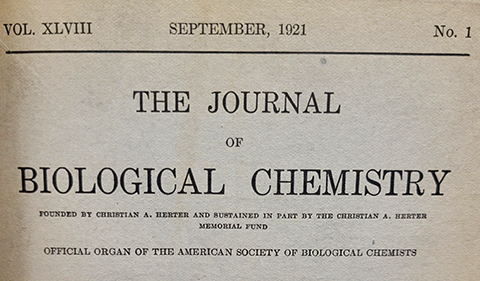Ten interesting quotes from the JBC archives
The first issue of the Journal of Biological Chemistry was published in October 1905. As a gold open-access publication, JBC has made every article published since then freely available to the public. By navigating to Past Issues, anyone can explore the vast scientific history preserved in those volumes.
In the older papers, archaic quirks like spelling “protein” as “proteid” remain, but also entire biological concepts, including the brain-derived protagon, that have long been abandoned. Some show flashes of ideas that later grew into their own fields, and others show that some things never change.

A good number of the articles are surprising, interesting or amusing, which inspired this collection of quotes.
1. Supplee and Dow, 1927. Vitamin A potency of irradiated milk.
“Drummond has likewise pointed out the possibilities of vitamin A destruction in irradiated milk, and he also calls attention to the fact that important, and presumably unfavorable changes are brought about by irradiation as manifested by the fact that milk exposed for as short a time as 5 minutes is highly unpalatable.”
2. Folin, Denis and Smillie, 1914. Some observations on “emotional glycosuria” in man.
“From Dr. Earl D. Bond we have received the report of 664 consecutive urine examinations made at the Danvers State Hospital for the Insane.”
3. Fales, 1922. An analysis of camel’s colostrum.
“Since reports of analyses of milks, other than those of the cow and goat, are none too plentiful it seems of possible value to have a published record of this analysis.”
“From these experiments we conclude that the beneficial action of ultra-violet light in preventing rickets in chickens is due to its direct action on the chickens and not the changes which it produces in the air the chickens breathe.”
5. Osborne and Mendel, 1913. The influence of butter-fat on growth.
“The striking way in which butter, thus supplied, influenced the growth of these young rats made it evident that it furnishes some substance which exerts a marked influence on growth.”
6. McCollum et al., 1918. The dietary properties of the potato.
“This [favorability of the potato as food] has been attributed, and probably correctly, to the lack of flavor in the potato, which makes it possible to confer palatability upon it by the addition of milk, butter, cream, salt and pepper, or by frying in fats.”
7. Abderhalden, 1913. Comments on the communications of Folin and Denis.
“I have reluctantly referred to this matter since the form and tone of Folin and Denis’s objections might wrongly give rise to the impressions that our criticisms were not made in the most amicable and impersonal spirit.”
8. Warner and Edmond, 1918. Blood fat in fowls.
“There is, however, another and more important reason for not seriously considering the results of their experiments. A casual examination of the following table from their paper suggests to our minds that the work does not fulfill the requirements for carefully controlled experimental study.”
9. Crowdle and Sherwin, 1922. The chemical defence mechanism of the fowl.
“Detoxication processes in the organism of the fowl have thus far received but little attention, due no doubt, in part at least, to the disagreeable features of a mixture of urine and feces.”
10. Wang, 1921. The composition of Chinese edible birds’ nests and the nature of their proteins.
“The material used for this work was supplied by the Hoo Loong Edible Birds’ Nest Store, Chicago, which imported it directly from China.”
Enjoy reading ASBMB Today?
Become a member to receive the print edition four times a year and the digital edition monthly.
Learn moreGet the latest from ASBMB Today
Enter your email address, and we’ll send you a weekly email with recent articles, interviews and more.
Latest in Science
Science highlights or most popular articles

Building the blueprint to block HIV
Wesley Sundquist will present his work on the HIV capsid and revolutionary drug, Lenacapavir, at the ASBMB Annual Meeting, March 7–10, in Maryland.

Gut microbes hijack cancer pathway in high-fat diets
Researchers at the Feinstein Institutes for Medical Research found that a high-fat diet increases ammonia-producing bacteria in the gut microbiome of mice, which in turn disrupts TGF-β signaling and promotes colorectal cancer.

Mapping fentanyl’s cellular footprint
Using a new imaging method, researchers at State University of New York at Buffalo traced fentanyl’s effects inside brain immune cells, revealing how the drug alters lipid droplets, pointing to new paths for addiction diagnostics.

Designing life’s building blocks with AI
Tanja Kortemme, a professor at the University of California, San Francisco, will discuss her research using computational biology to engineer proteins at the 2026 ASBMB Annual Meeting.

Cholesterol as a novel biomarker for Fragile X syndrome
Researchers in Quebec identified lower levels of a brain cholesterol metabolite, 24-hydroxycholesterol, in patients with fragile X syndrome, a finding that could provide a simple blood-based biomarker for understanding and managing the condition.

How lipid metabolism shapes sperm development
Researchers at Hokkaido University identify the enzyme behind a key lipid in sperm development. The findings reveal how seminolipids shape sperm formation and may inform future diagnostics and treatments for male infertility.

